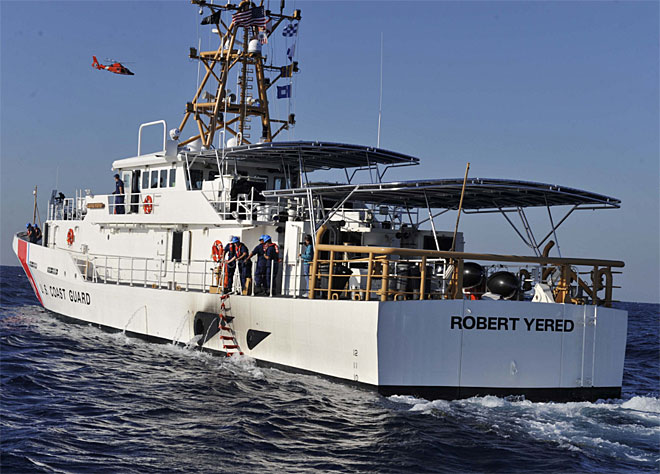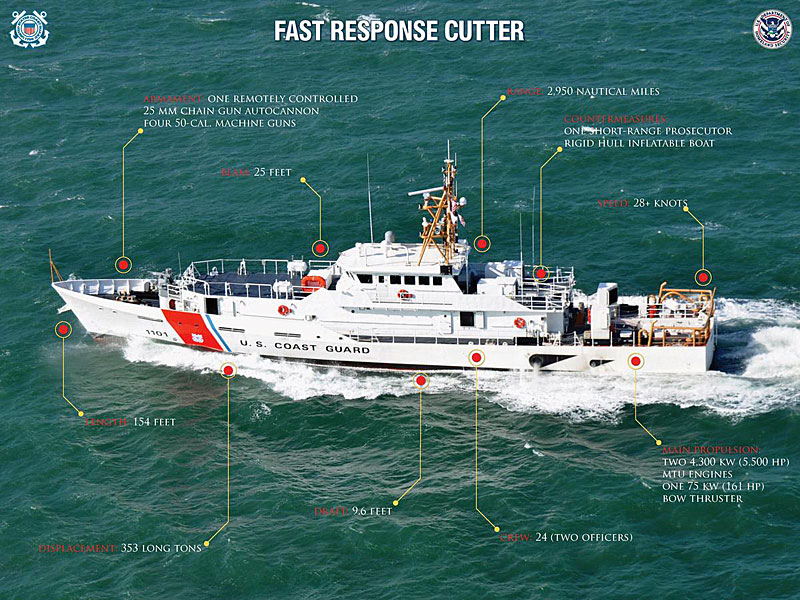
In 1830, the Revenue Cutter Service, predecessor to the modern Coast Guard launched its first standardized multi-ship class of cutters.
The Morris-class, named for the first cutter in the class, Robert Morris, was designed with a topsail-schooner rig and a length of 78 feet.
These cutters carried six 9-pound cannons and a crew of 24 officers and men.
The thirteen Morris-class cutters fought pirates, interdicted smugglers, enforced federal maritime laws and operated with American naval forces in time of war.
In the years leading up to the American Civil War, Cutter Morris and her sister ships formed the backbone of the revenue cutter fleet.
As with the Morris class, the Coast Guard is building a class of cutters designed to serve a multi-mission role.
(Go aboard the state-of-the-art US Coast Guard Cutter ‘James’. ‘James’ is the most technologically advanced ship in the Coast Guard fleet. Courtesy of Fox News and YouTube. Posted on Mar 31, 2017)
The “Sentinel” – Class Fast Response
The Sentinel-class fast response cutter is a new Coast Guard patrol boat that is capable of deploying independently to conduct missions that include port, waterways and coastal security; fishery patrols; search and rescue; and national defense.
Cutters (FRC) perform drug and migrant interdiction; ports, waterways and coastal security; fishery patrols; search and rescue; and national defense.
Why this program?
Named after Coast Guard enlisted heroes, the FRCs are replacing the aging Island-class 110-foot patrol boats.
The Sentinel Class patrol boat project will deliver vital capability to the Coast Guard, helping to meet the service’s need for additional patrol boats.
The current patrol boat gap hinders the Coast Guard’s ability to successfully and efficiently complete all potential missions, and this critical FRC acquisition will help address these identified needs.

Acquisition Strategy
The Coast Guard selected a “parent-craft” design for the Sentinel Class patrol boat to ensure that the operating force receives new patrol boats, capable of performing the required missions, as quickly as possible.
The Coast Guard coined the term “parent craft” to describe the use of an existing ship design that has successfully performed equivalent missions.
The Coast Guard followed a disciplined acquisition strategy including careful analysis of:
- Operational requirements
- Conducting worldwide market research
- Close consultation with Coast Guard technical authorities
- Use of the services of the U.S. Navy
- Use of independent commercial agents
- A full and open competition, and
- An assessment of the most competitive designs put forth by industry
(Learn More. Courtesy of Sage Monitor and YouTube. Posted on Apr 18, 2017)
In the next few years, the Coast Guard will deliver 32 additional cutters bringing our service numbers up to 58 FRCs intended to replace the fleet of 1980s-era 110-foot patrol boats.
The FRCs feature advanced command, control, communications, computers, intelligence, surveillance and reconnaissance equipment; over-the-horizon cutter boat deployment to reach vessels of interest; and improved habitability and sea-keeping characteristics.
Twenty-six FRCs are currently in service, with six stationed in Miami Beach, Florida; six in Key West, Florida; six in San Juan, Puerto Rico; two in Ketchikan, Alaska; two in Cape May, New Jersey; two in Pascagoula, Mississippi; and two in Honolulu, Hawaii.
As with their FRC sister cutters, the next flight of 19 FRCs will bear the names of enlisted leaders, trailblazers and heroes of the Coast Guard and its predecessor services of the U.S. Revenue Cutter Service, U.S. Lifesaving Service and U.S. Lighthouse Service.
These new cutters will be named for:
- Master Chief Angela McShan
- Surfmen Pablo Valent and Frederick Hatch
- Mustang Officer Maurice Jester;
- Electrician Myrtle Hazard Coxswains Harold Miller, William Sparling, Daniel Tarr, Glenn Harris and Douglas Denman
- Pharmacists Mate Robert Goldman
- Stewards Mates Emlen Tunnel and Warren Deyampert
- Seamen John Scheuerman and Charles Moulthrop
- Boatswain’s Mates Clarence Sutphin and Edgar Culbertson; and
- Keepers William Chadwick and John Patterson
These enlisted namesakes include recipients of the Navy Cross Medal, Silver Star Medal, Bronze Star Medal, Gold Lifesaving Medal, Silver Lifesaving Medal, Navy & Marine Corps Medal and Purple Heart Medal.
(On June 22, 2017, Coast Guard Vice Commandant Adm. Charles Michel met with the leadership and workforce at the Fairbanks Morse facility in Beloit, Wisconsin. Courtesy of USCG and YouTube. Posted on Jun 23, 2017)
The Fast Response Cutters are the mainstay of the Coast Guard’s coastal patrol fleet, providing multi-mission capabilities and interagency interoperability.
To learn more, check the Coast Guard Acquisition Directorate’s FRC web page at: http://www.dcms.uscg.mil/Our-Organization/Assistant-Commandant-for-Acquisitions-CG-9/Programs/Surface-Programs/Fast-Response-Cutters/
















